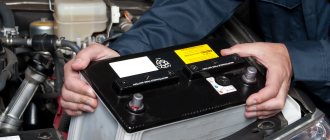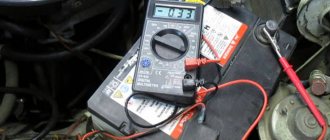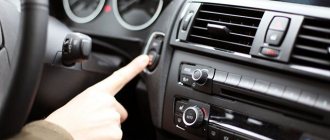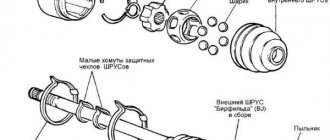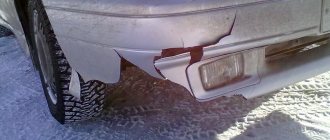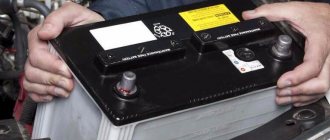For many people, the morning begins with warming up the car to go about their business, and it can be very unpleasant when, when the ignition is started, instead of the sounds of the starter, there is silence. This happens when the battery is discharged. The moment is unpleasant, but quite ordinary. It is for this reason that every car enthusiast needs to know how to charge a completely discharged car battery at home.
There are no difficulties in this matter. You just need to know the process technology and follow it. In general, if this is not the first time you have encountered a similar problem on your car, then you should think about purchasing a new battery. This will be easier than increasingly solving the problem of how to charge a car battery with a charger. The article will discuss this topic and describe all the nuances of the process. Let's start with some general information.
Battery device
Let's look at the example of an acid model (lead-acid):
- The body is made of plastic that is resistant to aggressive environments.
- The housing contains several cans (usually six), each is a source of current. The banks are connected to each other.
- Each jar contains special packages. They consist of plates (lead cathode and lead dioxide anode, respectively). A pair of such plates is a current source; they are connected in parallel, which allows the output voltage to be increased many times over.
- The bags are filled with a special solution (chemically pure sulfuric acid, which is diluted to a certain density with distilled water).
In principle, this completes the battery design; you can move on to questions regarding how to properly charge a car battery with a charger. Let's start in order.
When does a car battery need to be charged?
The installed battery is monitored for open circuit voltage, which should be 12.5 V. The operating voltage is measured at the terminals after the battery is charged on the bench or using a booster. The density of the electrolyte in all banks must be the same, corresponding to the operating conditions of the vehicle. Measurements are taken with the engine running at a shaft speed of 1500-2000 rpm and the high beams on. It is normal if the mains voltage is 13.8 - 14.5 V. Both undercharging and overcharging have consequences for the technical condition of the battery.
For low-maintenance and hybrid batteries, periodic monitoring of the density and electrolyte level is mandatory. Maintenance-free batteries have no caps, are sealed, and can be used as long as they hold a charge. What is important for them is the stability of the network voltage and the absence of discharge to zero.
How to charge a completely discharged car battery?
There are two ways in this situation. The first is to remove the battery from the engine compartment of your "iron horse", take it home and charge it there. The second way is to charge on site, but to do this you need to find an electrical source near where you park your vehicle.
Next, after you decide on the method, you can start charging. How to charge a completely discharged car battery? Using a special “charger”. It is worth understanding that in this way you will be able to charge a battery that has recently been completely discharged. If this happened a long time ago, then perhaps your battery cannot be helped at home or cannot be helped at all.
The charger is supplied with instructions for use. The nuances are described in detail there. We will only briefly explain that there are classic chargers, and there are automatic devices. If we talk about the “automatic”, then everything is simpler, just connect it to the network and to the battery, and the charging process will happen by itself. In principle, this is the simplest answer to the question of how to charge a completely discharged car battery.
If we talk about the classic “charger”, then the charging current is manually set and the process is completely under your control and with your participation. Such devices are cheaper, and many car enthusiasts (especially those with more experience) consider them more reliable, but no evidence for this statement can be found. How to charge a car battery with this type of charger? Following the instructions, depending on the capacity of your battery and its other parameters. But there is one general rule. It concerns how to charge a completely discharged car battery. Always start charging a dead battery with a low current (about 5-10% of the total capacity). During the charging process, the current is gradually reduced.
How to start a car with a dead battery
If there is no time or opportunity to charge the battery, you can start the engine in other ways. The most common is to crank the starter from the battery of another car (“light it”). There are many myths associated with this procedure, mostly concerning the order of connecting wires to the donor car and to the car that needs to be started. In fact, the order of joining does not matter. It makes little sense to connect the positive wire first (in any order). In this case, accidental contact with the housing will not cause a short circuit.
Connecting wires when lighting a cigarette.
The main thing is to be sure that the engine will start. There must be an obvious reason for battery discharge - headlights forgotten to be on, etc. If the battery is discharged due to several unsuccessful starts, it is better to avoid “lighting up”, otherwise it will end with two dead batteries. You also need to take into account that the donor battery must be no less capacious and no less powerful than the standard battery. Otherwise, this is also a direct way to end up with two dead batteries instead of one.
If the battery is completely discharged, and the donor car is not nearby or cannot drive up so that it is possible to connect the wires, you can crank the engine without using the starter. You can also rotate the shaft from the wheel side. This can be done “from a pusher” or by towing.
Both methods are categorically not acceptable for cars with an automatic transmission.
Starting the engine "from the pusher".
In principle, both methods are the same, only in the first case mechanical traction is used, and in the other, the muscular strength of one or two people is used (efforts are made easier if it is possible to push the car downhill). The procedure is as follows:
- the driver sits behind the wheel and turns on the ignition (so that the steering is not blocked);
- the clutch is depressed;
- second (or third) gear is engaged;
- towing or pushing of the car begins.
If the car is towed by another vehicle, you must start moving smoothly, first taking out the slack in the cable. When accelerating to a speed of about 20 km/h, the clutch must be released. As soon as the engine starts, the clutch pedal must be pressed again to prevent the engine from stalling. After this, a signal is given to the towing driver or pushers to stop the movement.
Start of car towing.
Another way is to start the engine from a starter-charger (not to be confused with a charger). If you don’t have time to wait several hours for the battery to replenish its energy level, you can start the engine from ROM and hope that the battery will charge on the road. We must take into account the risk of stalling at the very first traffic light (this applies to all of the listed methods of starting with an “empty” battery), and the problem will have to be solved on the spot.
Starter charger.
There are also exotic launch methods. They are either not very effective (like starting with a screwdriver battery), or they can completely kill the battery (like pouring alcohol-containing liquids inside).
Described in more detail in the article: 9 ways to start a car with a dead battery
Safety regulations
Essentially, there is nothing dangerous in the question of how to charge a car battery by charging, but there are unusual situations. All you need is a little attention, and then all risks will be reduced to zero. The charging process usually takes about ten hours. If the battery has not been charged within this period, then something is going wrong, and this should alert you.
During the charging process, you should ensure that the battery does not heat up or boil. If it boils, it will fail, and it can be very dangerous.
How to charge calcium car batteries?
Similar batteries have appeared in modern cars. They are labeled Ca/Ca or simply Ca. These batteries have improved characteristics, but differ markedly from their predecessors, including the charging process. The standard scheme is inappropriate here.
To charge them, you will need a special charger (it is advisable to take a model with a programmable cycle). How to charge a maintenance-free car battery (calcium) in this case? To charge, you need a higher voltage (about 16.5 volts). Only with this voltage will you be able to fully charge a calcium battery to 100%. If the “charger” produces only 14.8 V, and then the electronics cut it off, then your calcium battery will only be recharged halfway. This needs to be taken into account.
Moving the battery to your home
It happens that a driver rarely drives a car in winter. In this case, experienced drivers strongly recommend removing the battery and storing it in a dry, warm room. The recommendation is supported by the fact that a non-working battery at low temperatures quickly deteriorates in its characteristics. Sometimes this even leads to irreversible damage to the battery.
During such storage, it is important not to forget to charge the battery at least once every 3 months. Then he will always be in “combat” readiness.
In conclusion, we emphasize: be attentive to the car and to yourself. Many unpleasant situations will not happen if you think about your safety in advance. Proper use of the battery will allow you to avoid malfunctions. Careful preparation of the car before a long journey will allow you to get to your intended destination without unnecessary incidents.
Maintenance free batteries
Almost the entire process is common, but there are some nuances, so it should be said about how to properly charge a maintenance-free car battery. The peculiarity is the control of the supplied voltage. In most cases (there are rare exceptions to this rule), you need to apply a voltage of no more than 14.4 V to the terminals (in the above exceptions, this figure should not exceed 16 V). Control is needed so that under high voltage, water in the electrolyte can begin to disintegrate into oxygen and hydrogen. This will lead to a decrease in the electrolyte level and an increase in its density, and it will not be possible to add water to a maintenance-free battery. This is something to keep in mind if you are thinking about how to charge a maintenance-free car battery.
Charging maintenance-free batteries can be carried out not only at home, but also directly in the car. If you removed the battery, then you will need to connect the plus terminal of the charger to the plus terminal of the battery, and the minus terminal of the charger to the minus terminal of the battery.
Next, you need to set the voltage regulator knob on the charger to the extreme left position (minimum voltage) and only after this manipulation can you turn on the charger to the network. After this, you can set the charge voltage to 14.4 volts, and the battery charging process will begin.
An indicator that the battery charging process is complete will be the value of the charging current on the device display. When the voltage at the battery terminals reaches 14.4 V, the charging current drops to a minimum value of 200 mA. This will mean that your maintenance free battery charge is 100% done and complete.
Peculiarities:
- The charging current should never be allowed to exceed one-fifth of the capacity of a maintenance-free battery. Excess current in this case is dangerous for the battery itself.
- In the case of the deepest discharge of the battery, you need to start charging it with a voltage of 12 V and no higher. When the charging current rises to 0.1 of your capacity, you can increase the voltage to 14.4 V and continue as per the scheme we discussed above.
- If the battery is recharged directly in the car, then additional precautions must be taken in this situation. You will need to turn off or put into sleep mode the ignition and all other electrical devices of your vehicle. Only after this can you connect the charger and start charging according to the above scheme.
Now you are aware of all the nuances in the question of how to properly charge a maintenance-free car battery yourself at home if you have your own “charger”.
What to pay attention to when charging a car battery
The first point: choosing a device. How to charge a battery if it is completely discharged using devices sold in stores? The market offers a fairly wide range of these products, which can be:
- manual;
- semi-automatic;
- with automatic adjustment.
The first two varieties are the most popular, which is due to their high reliability, relative simplicity of design (in case of breakdown, self-repair is sometimes possible) and affordable cost.
How to charge a car battery that is completely discharged? When charging the battery, observe the polarity. If the wires are mixed up, the battery will be discharged, but not restored. Next, find out from the label the capacity of your battery, which is indicated in ampere hours. You need to charge with a current of 1/10 of the capacity. Example: if the battery has a capacity of 55 ampere-hours, for charging you need to supply a current of 5.5 A. In this case, the time to restore the battery will be 5.5 hours. You can increase the current strength (it is not recommended to set more than 15 A), but then you will have to control the charging process: if gases are released rapidly, reduce the energy supply to 0.5 A and leave the battery in this position for another couple of hours. In this case, you must unscrew the plugs (if the battery is serviceable). But still, the best option is to use a small current for charging.
What to do with maintenance-free batteries and how to charge a car battery after a deep discharge? The sealed housing of such devices does not allow checking the density of the electrolyte. Charging must be carried out using a charger whose current is set to 2 A. In this case, the voltage at the battery terminals should not exceed 15.5 V. When the device readings reach 0.2 A, the procedure can be considered complete.
Services
It happens that there is no time to charge the battery. Sometimes this cannot be done because you do not have your own charger. It also happens that some car enthusiasts do not understand the structure of their car. The answer for all these options to the question of how to fully charge a car battery is to contact a special service that provides similar services. A one-time charge will cost you about 150 rubles.
But it’s worth remembering that you shouldn’t limit yourself to charging alone. Sometimes you need a little more manipulation to extend the life of your battery. Services include measuring the density of the electrolyte (if necessary, the density will be increased or decreased). Such services cost about 100 rubles. Prices are relevant for most regions of Russia.
Home storage
Some car enthusiasts who usually drive domestically produced cars take the battery home every evening. There they recharge it or simply keep it warm, and every morning they are confident in their battery. Of course, this is correct, but not entirely. At a minimum, the car remains without an alarm system at this moment. And in general, where has it been seen in the modern world to constantly carry a heavy battery with you? Isn't it easier to buy yourself a decent battery and solve the problem once for several years? Of course, everyone answers this question themselves.
New battery
As a rule, a new battery does not need to be charged, that is, after purchase it is completely ready for use. But some control will not be superfluous. After completing your first ride with a new battery, you should immediately measure the voltage. During the check, you must turn off the car's ignition.
In addition, inspect your battery at least once every two weeks (for possible mechanical damage and accumulation of dust and dirt, which should be removed regularly).
Periodically check the terminals of your car to prevent them from oxidizing, and also check the tightness of the housing and all outlet holes on the battery.
If you are “lighting” your car from another, then make sure that the wiring does not burn out (turn off the ignition). Once a month, check the performance of the relay regulator, as well as the car generator. Periodically measure the battery voltage and do not allow this indicator to drop critically to 30%. Now you know not only how to charge a car battery with a charger, but also how to monitor the situation so as not to get into trouble with the battery.
It is worth saying that you do not need to charge a new car battery if you trust the seller. If there is no 100% confidence, then it would be a good idea to measure the voltage at the terminals at the time of purchase. This is done quite quickly and protects you from unpleasant situations.
When to charge the battery
Before charging the battery, you must ensure that it is truly discharged. There are several ways to do this:
- Measuring voltage at terminals . This can be done using a constant voltage voltmeter, in other words, an electronic multimeter or a pointer tester. For standard batteries used in most passenger cars, the standard voltage value is 12 V. In practice, it differs slightly from the nominal value. So, a value equal to 12.7 V tells the car owner that the battery charge level is 100%, and accordingly, there is no need to charge it. If the measured voltage is 12.2 V, then this indicates that the charge level is approximately 50%. And if the voltage drops to 11.6...11.7 V, it means that the battery is almost completely discharged and it needs additional charging.
- Measuring the electrolyte density value . However, this verification method is only possible for so-called serviceable batteries, that is, in which it is possible to reach containers with electrolyte (and add it, if necessary). To measure density, a special device is used - a hydrometer. The electrolyte density should be around 1.27 g/cm³. If it is significantly less, it means that the battery should be charged with a charger. In unattended ones there is a special window where 3 stages of density will be displayed.
- Problems starting the engine . One of the reasons why the starter does not turn, and problems arise with starting the engine, is precisely the battery discharge. This is usually accompanied by problems in the operation of other consumers of electricity in the car - lighting, operation of the audio system, and so on.
In a discharged battery, sulfation of its lead plates occurs, which leads to a sharp decrease in its service life, that is, durability.
Disposal of old battery
In no case can we ignore this topic, especially in our difficult times, when the environment is in a deplorable state. Batteries that have reached the end of their service life are not safe for human health and have a negative impact on the environment. The merit of this is the materials and substances of the battery. Today, there are two main types of car batteries (acid and alkaline). Moreover, the first type occurs many times more often than the second.
Every car enthusiast should understand that an old battery cannot simply be thrown into a landfill or into a roadside ditch. Batteries must be collected and disposed of in an appropriate manner.
In Russia at present the situation is not as depressing as it was at least 15-20 years ago. Now there are many collection points for used batteries, where they will give you real money for a battery that is no longer useful. Also, in many stores you can get a discount on a new battery if you give them your old one. This saves money and takes care of the environment, which is important.
Manufacturers
This is a moment that also cannot be ignored, as it is important. Experienced car enthusiasts recommend giving preference to famous brands; they cost a little more, but this is a certain guarantee of high quality. It can be said that when it comes to car batteries, a stingy person can pay twice. This rule holds true, as confirmed by numerous reviews and opinions of authoritative people in the automotive field.
If we talk about foreign brands, it is worth highlighting Varta and Bosch. Both brands come from Germany. The batteries from these manufacturers are not the cheapest in the segment, but are distinguished by high quality workmanship and a long service life.
If we talk about domestic manufacturers, then it is worth focusing on “Titan” and “Akom”. These companies make very high quality products. There is an opinion among car enthusiasts that Akom batteries are generally better than even famous imported analogues. This opinion is not taken from heaven, this is real experience and tests of reputable companies in this industry.
Of course, the list of worthy examples does not end with four brands. We just mentioned four brands that stand out from the crowd of companies specializing in the production of car batteries.
Therefore, before buying a new battery, you should ask people who have already been through a battery replacement situation, compare manufacturers, pricing policies, characteristics, and read reviews. Of course, the best adviser in this situation is experience, preferably personal or people you completely trust.
In general, there is a trend that is definitely applicable to foreign-made cars. It lies in the fact that the battery that is supplied with the vehicle from the manufacturer lasts the longest. From here we can draw some not entirely good conclusions about our stores and their integrity.
Bottom line
The battery is an important part in a car. You cannot treat it negligently, so as not to encounter problems because of it. Today you learned how to charge a car battery with a charger and everything that is somehow related to this issue. Treat your battery correctly, check it periodically and change it if necessary.
The average lifespan of a car battery is about five years. There are especially high-quality batteries that can last up to eight years. If you do everything correctly and approach the issue wisely, then you will never be faced with unpleasant surprises even on the frostiest morning, when you are rushing about your most important and urgent matters. After all, as a rule, a problem with the battery occurs precisely under such circumstances.
Video
We invite you to watch a video on how to properly charge a car, the devices used, and how to properly prepare the equipment for restoration.
The generator supplies the vehicle with energy while driving. When the engine stops, the battery takes over the “feeding” function.
The service life of this unit lasts on average 2-3 years (equivalent to 80-100 thousand kilometers). The battery stores energy rather than generating it. At the moment when it is at least half discharged, you should think about recharging. Here are some tips.



